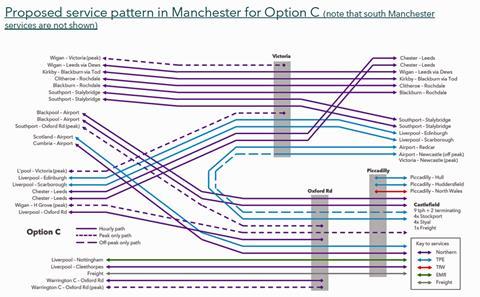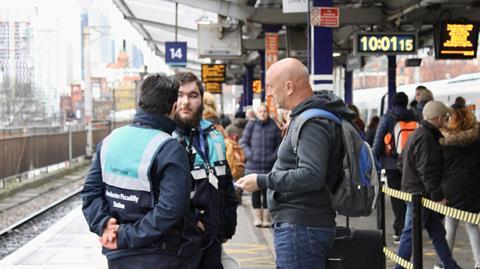
UK: A public consultation on options for a recast of services around Manchester to improve performance and reliability was announced by the Department for Transport and Transport for the North on January 14.
The city’s local rail network has been acutely congested for many years, but the situation came to a head in the months following the May 2018 timetable change which saw the full opening to traffic of the Ordsall Chord, providing a through route between the city’s two main stations, Victoria and Piccadilly.

This in turn added to the volume of traffic passing along the Castlefield Corridor which links Piccadilly and Oxford Road stations and is shared by many passenger and intermodal freight services. Opening of the chord led to a further decline in reliability in this corridor, leading local policymakers to urge government to address it.
The onset of the coronavirus pandemic in March 2020 and the subsequent collapse in demand for travel led local operators to thin out the number of trains running across Manchester, and this in turn has led to a noticeable upturn in performance.
Now DfT, TfN and industry partners have produced a series of options which are intended to showcase how a more resilient timetable could be produced to give Mancunians a more reliable service as the pandemic eases over the coming months.
The favoured option is expected to be implemented from the May 2022 timetable change.
Three timetable options
All three options involve thinning out services, with some routes split into two rather than crossing the city.
While the focus of the recast is on central Manchester, a major related challenge is the provision of services to Manchester Airport, which prior to the pandemic had been a major traffic generator served by a steadily increasing number of direct trains from destinations across northern England, Wales and Scotland. However, industry insiders report that the consultation is likely to lead to a cut in long-distance services to the airport in favour of the reintroduction of more shuttle services to and from Piccadilly.
Of the three proposals in the consultation, Option A would retain most origin and destination pairs; Option B is a variant that maintains a direct service from Liverpool to the airport but removes the one from Sheffield and Cleethorpes, which is described by DfT as ‘very operationally challenging’ because of the need to reverse at Manchester Piccadilly.
Option C makes the most interventions and introduces a near-30 min interval services on most corridors into Manchester, including the Blackburn, Calder Valley, Chorley, Wigan, Buxton, Warrington/Chester, Manchester Airport and Crewe routes.

DfT says the chosen outcome would ‘improve overall reliability significantly while maintaining the pre-Covid journey connections for the vast majority of passengers’, but it notes that some passengers may need to make ‘different choices for travel’.
‘We are putting the power to improve Manchester’s rail network in the hands of those that use it daily’, explained Rail Minister Chris Heaton-Harris. ‘Improving punctuality and reliability is one of my key priorities. As we continue to build back better from the pandemic, these proposals will ensure that the rail network is more dependable for those who use it every day.’
Mayor of Greater Manchester Andy Burnham said ‘I welcome this consultation and the government’s focus on this issue. The bottleneck in central Manchester is a problem for the whole of the north — and solving these congestion issues will improve the reliability of rail services for passengers right across northern England.’




